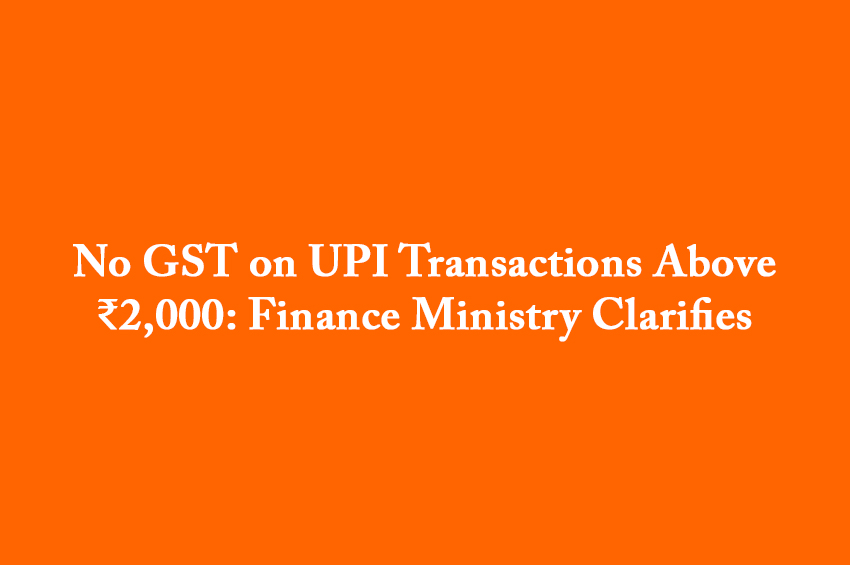Winning Bizness Desk
Mumbai. The Ministry of Finance has categorically denied recent reports suggesting the imposition of Goods and Services Tax (GST) on Unified Payments Interface (UPI) transactions exceeding ₹2,000. In an official statement released on April 18, 2025, the ministry termed such claims as "completely false, misleading, and without any basis," affirming that no such proposal is under consideration.
Zero Merchant Discount Rate Ensures No GST Applicability
Since January 2020, the government has implemented a zero Merchant Discount Rate (MDR) policy for UPI Person-to-Merchant (P2M) transactions. As GST is applicable only on services that attract MDR, the absence of MDR on these transactions means GST does not apply. This initiative aims to promote digital payments by reducing transaction costs for both merchants and consumers.
Extension of ₹1,500 Crore Incentive Scheme for Low-Value Transactions
In a move to further encourage digital payments, the Union Cabinet approved the extension of a ₹1,500 crore incentive scheme on March 19, 2025. This scheme, effective from April 1, 2024, to March 31, 2025, incentivizes low-value BHIM-UPI transactions up to ₹2,000, particularly benefiting small merchants. The initiative aims to deepen digital payment adoption at the grassroots level.
Incentive Structure for Merchants and Banks
Under the scheme, merchants receive a 0.15% incentive for each eligible transaction, making digital payments more attractive. For instance, a ₹2,000 transaction would earn the merchant ₹3. Additionally, acquiring banks are reimbursed 80% of the incentive amount promptly, with the remaining 20% disbursed upon meeting specific performance criteria, such as maintaining a technical failure rate below 0.75% and ensuring system uptime above 99.5%.
Government's Commitment to Digital Payment Ecosystem
The government's initiatives reflect its commitment to fostering a robust digital payment ecosystem. By eliminating MDR and providing incentives, the aim is to reduce the cost burden on stakeholders, thereby promoting the adoption of digital transactions across the country. These measures are particularly targeted at small merchants and consumers in semi-urban and rural areas.
UPI's Role in India's Digital Economy
UPI has emerged as a cornerstone of India's digital payment infrastructure, facilitating real-time fund transfers and a wide range of financial transactions. Its user-friendly interface and interoperability have led to widespread adoption, with transactions reaching significant volumes monthly.
Clarification Amidst Rising Speculations
The finance ministry's clarification comes amidst growing speculations and concerns among users and merchants regarding potential taxation on UPI transactions. By addressing these rumors, the government aims to maintain trust in the digital payment system and ensure continued growth in digital transactions.
Future Outlook for Digital Payments in India
With ongoing support and policy measures, the government envisions a significant increase in digital transactions, aiming to reach 20,000 crore transactions in the financial year 2025-26. Continued efforts to enhance infrastructure and provide incentives are expected to drive this growth, further integrating digital payments into everyday life across the nation.
Whole matter in a nutshell
1. The Finance Ministry denies plans to levy GST on UPI transactions over ₹2,000.
2. Reports suggesting such taxation are deemed false and misleading.
3. Zero MDR policy for UPI P2M transactions ensures no GST applicability.
4. A ₹1,500 crore incentive scheme has been extended to promote low-value UPI transactions.
5. Merchants receive a 0.15% incentive per eligible transaction under the scheme.
6. Acquiring banks are reimbursed based on performance metrics.
7. The initiative aims to bolster digital payment adoption among small merchants.
8. UPI continues to play a pivotal role in India's digital economy.
9. The government targets 20,000 crore digital transactions in FY 2025-26.
10. Clarifications aim to dispel misinformation and reinforce confidence in digital payments.


